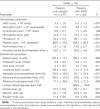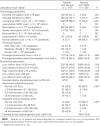Use of simple laboratory features to distinguish the early stage of severe acute respiratory syndrome from dengue fever
- PMID: 15578405
- PMCID: PMC7107824
- DOI: 10.1086/426029
Use of simple laboratory features to distinguish the early stage of severe acute respiratory syndrome from dengue fever
Abstract
Background: The diagnosis of severe acute respiratory syndrome (SARS) is difficult early in the illness, because its presentation resembles that of other nonspecific viral fevers, such as dengue. Dengue fever is endemic in many of the countries in which the large SARS outbreaks occurred in early 2003. Misdiagnosis may have serious public health consequences. We aimed to determine simple laboratory features to differentiate SARS from dengue.
Methods: We compared the laboratory features of 55 adult patients with SARS at presentation (who were all admitted before radiological changes had occurred) and 147 patients with dengue. Features independently predictive of dengue were modeled by multivariate logistic regression to create a diagnostic tool with 100% specificity for dengue.
Results: Multivariate analysis identified 3 laboratory features that together are highly predictive of a diagnosis of dengue and able to rule out the possibility of SARS: platelet count of <140 x 10(9) platelets/L, white blood cell count of <5x10(9) cells/L, and aspartate aminotransferase level of >34 IU/L. A combination of these parameters has a sensitivity of 75% and a specificity of 100%.
Conclusions: Simple laboratory data may be helpful for the diagnosis of disease in adults admitted because of fever in areas in which dengue is endemic when the diagnosis of SARS needs to be excluded. Application of this information may help to optimize the use of isolation rooms for patients presenting with nonspecific fever.
Figures



References
-
- Drosten C, Gunther S, Preiser W, et al. Identification of a novel coronavirus in patients with severe acute respiratory syndrome. N Engl J Med. 2003;348:1967–76. - PubMed
-
- Booth CM, Matukas LM, Tomlinson GA, et al. Clinical features and short-term outcomes of 144 patients with SARS in the greater Toronto area. JAMA. 2003;289:2801–9. - PubMed
-
- Poutanen SM, Low DE, Henry B, et al. Identification of severe acute respiratory syndrome in Canada. N Engl J Med. 2003;348:1995–2005. - PubMed
-
- Tsang KW, Ho PL, Ooi GC, et al. A cluster of cases of severe acute respiratory syndrome in Hong Kong. N Engl J Med. 2003;348:1977–85. - PubMed
Publication types
MeSH terms
Substances
LinkOut - more resources
Full Text Sources
Medical
Miscellaneous

